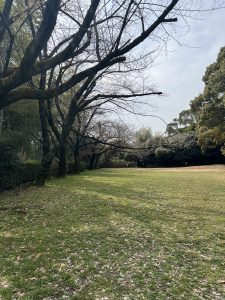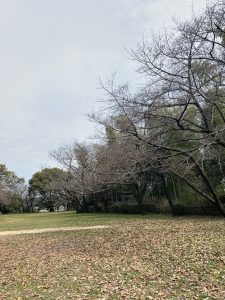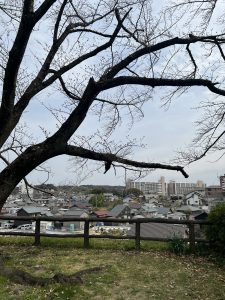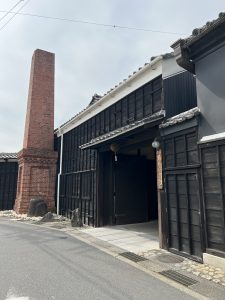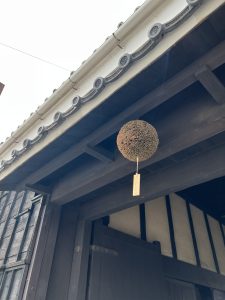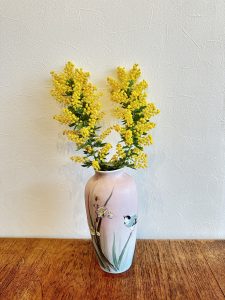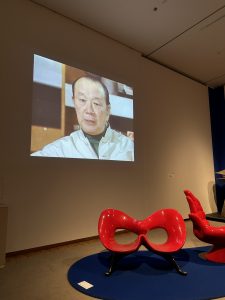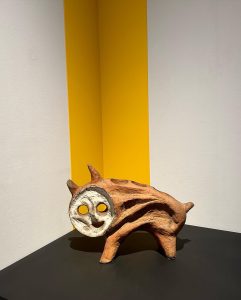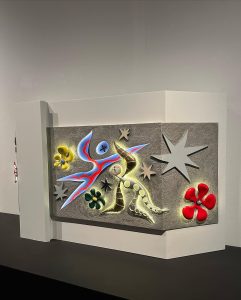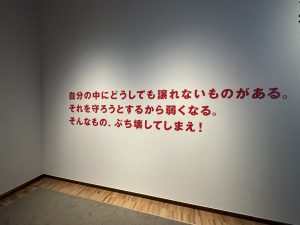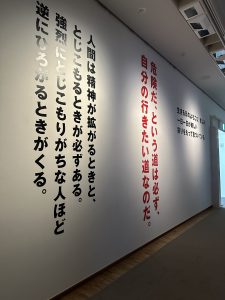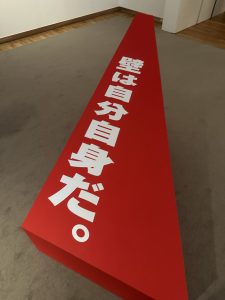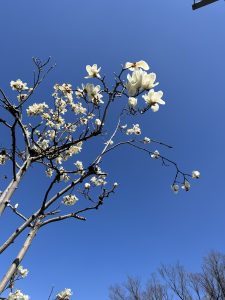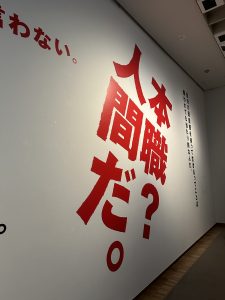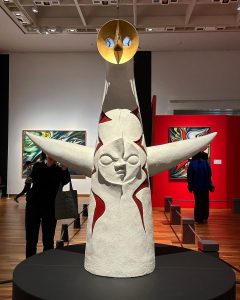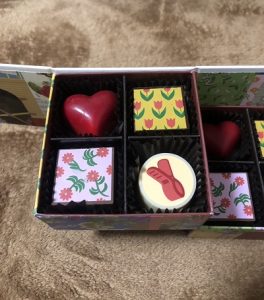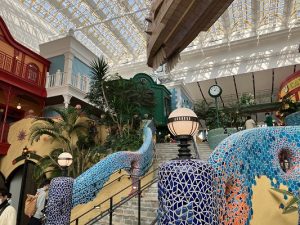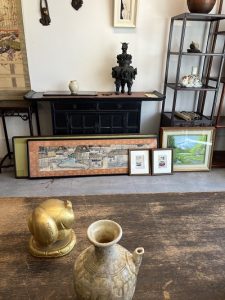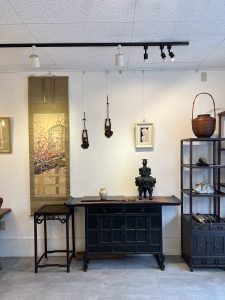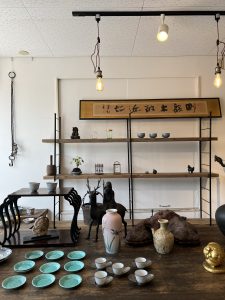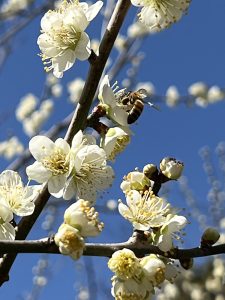大開運日に和菓子をいただきます(愛知県名古屋市千種区姫池通 骨董買取 古美術風光舎)
2023.03.21
皆さま、こんにちは。スタッフNでございます。
WBC日本決勝おめでとうございます。
ドラマのような展開だったようですね。
にわかの私もアメトークで予習しましたので、なんとなく状況をつかむことができました。
毎日知人がテレビを見て「ヌートバー!かっこいいヌートバー!大好きー!」と叫んでいるので、嫌でも覚えてしまいました。
そこまで言うので気になって調べてみますと、明るいお母さまもインタビューで出てきまして、ママ友事情などお話されていて、どこの家庭でも母親は同じ思いなんだなあと感じ、とても面白かったです。
今日は家で皆さまWBCを見ておられると思っていたのですが、東山動物園も人だかり、覚王山祭りで周辺も人が多かったです。
そういえば今日は祝日なのですね、通りで人が多いわけでございます。
本日3月21日は、1年に3回しかない大開運日だそうです。
今日のWBC勝利だけで日本は朝から大開運日の効果が出ている気が致します。
昼過ぎからはあいにくの雨ですが、きっとメキシコ選手の涙なのでしょう。
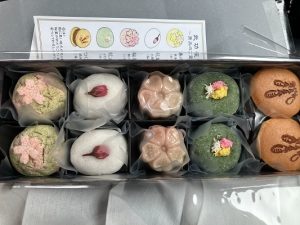
先日知人の両親の財布のプレゼント購入に付き合っておりましたら、もうすぐ大開運日なので使い始めるにはピッタリだとのことでした。
それに合わせて財布を新調する方も多くいらっしゃいました。
しかし、長財布で小さめとのことで、中々要望に応えられるものがなく、財布のプレゼントはやはり難しいですね。
話を色々聞いていて、一緒に財布を選んでいるうちに、Nも何かプレゼントをしたくなってきたのですが、顔も知らない他人から送られても戸惑うだけなので、気持ちだけ送っておきます。
ブログでも桜のお話が出ましたが、東山動物園では春まつりが開催されているようです。
4月1日からは宵の八重桜さんぽと称して、20時30分まで開園しているそうです。
こんなに近くにありながら、仕事の日は閉演時間がすぎてしまうので、行けない東山動物園。
この機会に帰り際に行けたらいいなと思っております。
動物園が夜までやっていたら、きっとNは毎仕事終わりに通っていることでしょう。
知人から可愛らしい和菓子をいただきました。
綺麗なお皿に並べて写真を撮りたかったのですが、その場でいただいてしまったので残念ながら撮れませんでした。
桜を見ながら、和菓子とお抹茶をお着物でいただいたら素敵だろうなとふと思いましたが、自転車で爆走しながら桜並木を駆け抜けていく方がNにはピッタリな気がいたします。
今日は和菓子について調べてみました。
和菓子とは、日本の伝統的な菓子全般のことを意味し、主に小豆や餅粉などを原料としているので、ふんわりとやさしい甘さが特徴でございます。
一方、洋菓子は小麦粉や卵、バターや生クリームなどの乳製品が多く使われ、しっかりとした甘さが特徴でございます。
また、季節の花・動物などをモチーフにしたりと形も見た目も様々で面白いです。
Nは動物好きなので、猫やあざらし、ライオンなどあのまん丸の中に可愛くおさまっている和菓子動物がたまりません。
インスタグラムでたまに流れてくる有名な和菓子職人の投稿をいつも眺めながら、取り寄せするか悩んでおります。
では、和菓子にはどのような種類があるのでしょうか。
- 餅物:赤飯、おはぎ、大福
- 焼き物:今川焼き、カステラ、どら焼き、きんつば
- 揚げ物:揚げ月餅、あんドーナツ
- 蒸し物:わらび餅、ういろう、蒸し饅頭
- 掛け物:あんみつ
- あん物:ぜんざい
- 練り物:ぎゅうひ、煉り切り
- 流し物:ところてん、羊羹
などなど、思った以上に様々なものが和菓子として出ておりました。
私たちが和菓子としてイメージするのは、練り物でしょうか。
赤飯はごはんではなく和菓子なのですね。
小さい頃、今川焼やたい焼きがいつも冷凍庫に常備されておりまして、毎日食べていた気がいたします。
あとは、甘いものを食べ過ぎてしまい、我慢しているときも、なぜか和菓子ならセーフな気がする。
と自分に言い聞かせておりました。
ケーキはアウトだけど、おはぎとか大福ならなんかセーフな気がする感覚、お分かりになりますでしょうか。
実際に、和菓子には小豆や寒天などの食物繊維が多く含まれています。
食物繊維は血糖値を抑えてくれるので、カロリーは低いのに満腹感があって、食べ過ぎを抑えてくれます。
また、食物繊維は体内の老廃物を掃除して便秘を解消する効果があるので、美容・健康効果が期待できるそうですよ。
和菓子にたくさん使われているあんですが、実は日本ではなく中国大陸にあるそうです。
「あん」は今から約1400年前、大和時代に遣隋使が大陸の文化とともに持ち帰ったものだとされています。
しかしそこから、現在の私たちがよく知っている「あん」の姿になるまでには長い歴史がありました。
日本の和菓子の歴史は、縄文時代までさかのぼるとされています。
木の実を粉砕して、水でアクを抜き丸めたものが、団子の始まりといわれています。
その後、唐(現在の中国)との交流や茶の湯文化の発展などの影響を受けながら和菓子は進化してきたのです。
「日本三大菓子処」といえば、金沢(石川県)・京都(京都府)・松江(島根県)だそうです。
世界一古い和菓子は、京都市北区紫野にある今宮神社にございます。
その脇の参道にあるあぶり餅屋「一文字和助(いちもんじわすけ)」こと「一和(いちわ)」の創業は、長保2年(西暦1000年)。
平安時代から続く日本最古の和菓子を、昔と変わらぬ製法で作り続けている老舗中の老舗だそうです。
ここまで読んでいたら、きっと和菓子が食べたくなってきたのではないでしょうか。
和菓子にぴったりなお皿、ご用意しておりますので是非古美術風光舎へお越しください。
いらない食器をお譲りいただいて、浮いたお金で和菓子でもいかがでしょうか。
ではでは
Hello everyone. Staff N.
Congratulations on the WBC Japan final.
It seems like it unfolded like a drama.
I also used AmeTalk to prepare for the class, so I was able to grasp the situation somehow.
Every day an acquaintance watches TV and shouts, “Nutbar! Cool nutbar! I love you!”
I was curious about that, so I looked it up, and I found a cheerful mother in an interview, and she talked about her friendships with her mother. .
I thought everyone was watching the WBC at home today, but there were a lot of people at Higashiyama Zoo and the Kakuozan Festival.
Come to think of it, today is a public holiday, so there are a lot of people on the street.
It seems that today, March 21st, is a day of good luck that comes only three times a year.
I feel that today’s WBC victory alone has the effect of a great luck day in Japan from the morning.
Unfortunately, it started raining after noon, but it must be the tears of the Mexican players.
The other day, when I was shopping for a wallet for my acquaintance’s parents, they told me that it would be a perfect time to start using it because it was a very lucky day.
There were many people who bought a new wallet to match it.
However, it is difficult to give a wallet as a gift because it is a small long wallet and there is nothing that can meet the request.
After listening to various stories and choosing a wallet together, N also wanted to give me a present, but I would be confused if someone I didn’t even know sent it to me, so I just sent my feelings. Put.
I talked about cherry blossoms on my blog, but it seems that the spring festival is being held at Higashiyama Zoo.
From April 1st, the park will be open until 20:30 under the name of Yoi no Yaezakura Sanpo.
Higashiyama Zoo is so close, but I can’t go there on work days because it’s too late to go.
I wish I could go on my way home on this occasion.
If the zoo was open until night, I’m sure N would go there every day after work.
I received a cute Japanese sweet from an acquaintance.
I wanted to take a picture of them lined up on a beautiful plate, but unfortunately I couldn’t because I received them on the spot.
While looking at the cherry blossoms, I suddenly thought that it would be nice to have Japanese sweets and matcha green tea in a kimono, but I feel that running through the cherry blossom trees while riding a bicycle would be perfect for N.
Today, I researched Japanese sweets.
Wagashi refers to traditional Japanese sweets in general, and they are characterized by their soft and gentle sweetness as they are mainly made from adzuki beans and mochi flour.
On the other hand, Western confectionery is characterized by a solid sweetness, which uses a lot of dairy products such as flour, eggs, butter and fresh cream.
In addition, the shape and appearance are various and interesting, such as seasonal flowers and animals as motifs.
N likes animals, so I can’t get enough of Japanese confectionery animals such as cats, seals, and lions that are cutely placed in the circle.
I always look at the posts of famous Japanese confectionery craftsmen that occasionally flow on Instagram, and I’m wondering if I can order them.
What types of Japanese sweets are there?
Rice cakes: red rice, ohagi, daifuku
Pottery: Imagawayaki, Castella, Dorayaki, Kintsuba
Deep-fried food: deep-fried moon cakes, bean paste donuts
Steamed food: warabi mochi, uiro, steamed buns
Kakemono: Anmitsu
Red bean paste: Zenzai
Paste: gyuhi, nerikiri
Dish: Tokoroten, yokan
Etc. More various things than I thought were out as Japanese sweets.
What we imagine as Japanese sweets is paste.
Sekihan is not rice, but Japanese sweets.
When I was little, Imagawa-yaki and taiyaki were always kept in the freezer, and I feel like I ate them every day.
Also, when I eat too much sweets and endure them, I feel that Japanese sweets are safe for some reason.
I was telling myself.
Cake is out, but do you understand the feeling that something like ohagi or daifuku is safe?
In fact, Japanese sweets contain a lot of dietary fiber such as red beans and agar.
Dietary fiber keeps your blood sugar in check, so even though it’s low in calories, it makes you feel full and keeps you from overeating.
In addition, dietary fiber has the effect of removing waste products from the body and relieving constipation, so it seems that you can expect beauty and health effects.
Bean paste is often used in Japanese sweets, but it is actually found in mainland China, not Japan.
“An” is said to have been brought back with the culture of the continent by envoys to the Sui Dynasty during the Yamato period about 1,400 years ago.
However, there was a long history from that point until it became what we are familiar with today.
The history of wagashi in Japan is said to date back to the Jomon period.
It is said that dango started when the nuts were crushed and the scum was removed with water.
Since then, Japanese sweets have evolved under the influence of exchanges with Tang (now China) and the development of tea ceremony culture.
Kanazawa (Ishikawa Prefecture), Kyoto (Kyoto Prefecture), and Matsue (Shimane Prefecture) are said to be the “three major confectioners in Japan”.
The oldest Japanese confectionery in the world is located at Imamiya Shrine in Murasakino, Kita-ku, Kyoto.
Ichiwa, also known as Ichimonji Wasuke, a roasted rice cake shop on the side approach to the shrine, was founded in 1000.
It is said to be a long-established store that continues to make Japan’s oldest Japanese sweets, which has been around since the Heian period, using the same method as in the past.
If you’ve read this far, I’m sure you’re craving for Japanese sweets.
We have plates that are perfect for Japanese sweets, so please come to Antique Fukousha.
If you donate the tableware you don’t need anymore, why don’t you buy some Japanese sweets with the extra money?
See you soon
********************
ご実家の整理やお片付けなどをされている方のご相談などが多くございます。
これから春に向かってお片付けを検討されていらっしゃる方も。
風光舎では古美術品や骨董品の他にも絵画や宝石、趣味のお品など様々なジャンルのものを買受しております。
お片付けをされていて、こういうものでもいいのかしらと迷われているものでも、どうぞお気軽にご相談下さいませ。
また風光舎は、出張買取も強化しております。ご近所はもちろん、愛知県内、岐阜県、三重県その他の県へも出張いたします。
まずは、お電話お待ちしております。
愛知県名古屋市千種区姫池通
骨董 買取【古美術 風光舎 名古屋店】
TEL052(734)8444
10:00-17:00 OPEN
#高価買取#無料査定#出張費無料#お片付け#生前整理#遺品整理#古美術#骨董#ご相談ください#和菓子#大開運日

